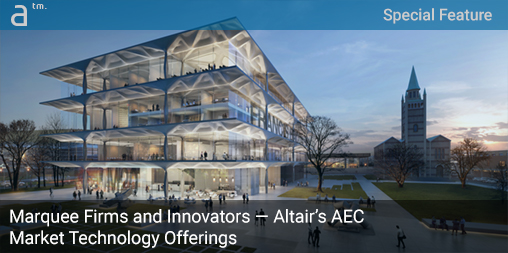Continued from page 1
Altair’s Latest Advancements
It has been five years since our last major feature on Altair. Dr. Frattari spent a good hour catching me up on where Inspire technology is today and what other products and technologies the engineering software company has aimed at the larger AEC technology market.

Zaha Hadid Architects (ZHA) is another longtime client of Altair’s engineering software, with results shown here such as the studded pavilion at the Morpheus Hotel in the City of Dreams project. (Image: ZHA via Altair Corporation / Architosh. All rights reserved.)
Elite design firms are still utilizing topology optimization software with demanding form-making problems. Zaha Hadid Architects (ZHA) used Altair software for developing its triangles studded pavilion for the Morpheus Hotel in the City of Dreams. The marquee architecture practice also tapped Altair’s HyperWorks platform for its 2015 competition entry for the 2015 Museum of the 20th Century in Berlin, adjacent to Mies van der Rohe’s Neue Nationalgalerie, Berlin, Germany.
We believe that clients reach the peak of performance improvements when they engage these kinds of workflows at the start of conceptual design.
ZHA’s computation and design research group (co|de) led the effort to produce a workflow from HyperWorks to OptiStruct and back again, creating a structure that was easier to fabricate. The overall results of that work were quite stunning, with material redundancies eliminated and weight reduction in concrete achieved with intelligent and efficient rib patterns.
Altair’s topology optimization technologies have continued to advance over the past five years, with new abilities to model geometric-based forms over “morphogenesis-looking” optimizations directly. Altair’s OptiStruct algorithms for topology optimization have permanently been embedded in Inspire since version 8.0 but at graduated levels of capability. Inspire includes technologies from other Altair product ranges and can be used for “design for additive manufacturing” (DfAM) plus more advanced topology optimizations.

An engineering analysis of ZHAs Berlin Museum competition entry. The heat map colors indicate stresses in the organic morphological form of the concrete floors and columns. (Image: ZHA via Altair Corporation / Architosh. All rights reserved.)
Beyond topology optimizations, Altair is helping architects design tall buildings better with CFD (computational fluid dynamics) analysis for wind force design. Firms like Fenwick Iribarren Architects to SOM use tools like Altair AcuSolve and HyperMesh to solve wind-disturbance and structural issues at the ground level and tower level of skyscrapers. SOM has also used Altair OptiStruct to develop material efficiencies for its LA courthouse project.

ZHA’s Museum of the 20th Century in Berlin, near Mies van der Rohe’s famous landmark, an interior view showcasing the organic morphological form of the structural floors and columns, all topologically optimized using Altair’s engineering software technologies. (Image: ZHA via Altair Corporation / Architosh. All rights reserved.)
Another exciting use of Altair technologies is in innovative composites for organic architecture. In 2018, designers and architects in Austria, working with the Institute of Architecture, University of Applied Arts Vienna, developed wood-carbon composite materials. Thin plies of wood veneers with plies of carbon fiber can be formed into various free-form shapes and curves and address complex, heavy loading patterns.
Altair’s HyperWorks suite and mainly its ESAComp tool for laminate design and analysis were brought together in the wood-carbon laminates, first proposed for the new Bulgarian Varna Library Facade and later for the Sella Chair technology demonstration.
The “Greta Effect”
Swedish teenage climate activist Greta Thunberg didn’t step onto the internal stage until 2018, but by 2019 the so-called “Greta Effect” was in full force. A more engaged and hardened push for addressing climate change emerged. More companies are turning to Altair’s technologies that help drive down the material mass and carbon footprints for production and attendant transportation.
Finding ways to design higher-strength but lighter material formations for building everything from cars to buildings and bridges is critical to lowering the carbon footprint of large industries like AEC and manufacturing. To achieve these goals faster, Dr. Frattari encourages not just the adoption of higher-fidelity engineering workflows like FEA, CFD, and topology optimization science and engineering but bringing these advances earlier in the design phase.

ZHA’s Museum of the 20th Century in Berlin, near Mies van der Rohe’s famous landmark, utilized Altair’s HyperWorks platform for a total workflow of topology optimization at the highest fidelity level possible. It led to this stunning architectural achievement for its competition entry. (Image: ZHA via Altair Corporation / Architosh. All rights reserved.).
“We believe that clients reach the peak of performance improvements when they engage these kinds of workflows at the start of conceptual design,” he says. To get Altair’s technology more embedded into a larger userbase of AEC industry engineers—and go beyond advanced engineering and computation and research groups in marquee global design firms like ZHA and SOM—the company recently acquired S-FRAME.
The Canada-based structural engineering software company offers complete solutions across every structural building material and fabrication method. Dr. Frattari says, “we are working on harnessing optimization via full interoperability to bring our solution into the many stages of the design workflow.”
Final Analysis
Altair’s acquisition of S-FRAME firmly places the company in the AEC software industry like never before. This will enable a range of Altair technologies to reach typical buildings similar to elite architectural projects by marquee architecture firms. This expansion is a positive step for the company as more pressure on AEC professionals puts zero-carbon design goals on their radar.
Additional Notes
To learn more about Altair and its AEC Technologies go here.
Image Credits
Format equates to “party with copyright” / “party with reserved rights of use.” (eg: image: Epic Games, Inc. / Architosh. All rights reserved.)
Title image credit: ( © Zaha Hadid Architects for Altair Technologies / Architosh. All rights reserved.) Non-credited images are copyrighted to Architosh. All other images are copyrighted, as noted in the image credits.







Reader Comments
Comments for this story are closed